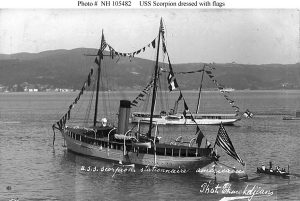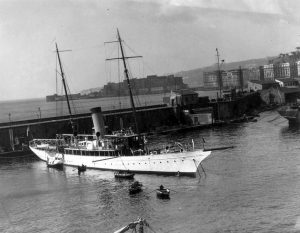 The State Department is getting a boat! A BOAT. It’s about bloody time. Every embassy in Oceania (at least!) should have a boat, and, frankly, America would be more secure if there were some floating consulates wandering about the Pacific, facilitating better engagement and collecting intel first-hand (I’ve kvetched about the lack of State Department hands-on engagement for almost a decade).
The State Department is getting a boat! A BOAT. It’s about bloody time. Every embassy in Oceania (at least!) should have a boat, and, frankly, America would be more secure if there were some floating consulates wandering about the Pacific, facilitating better engagement and collecting intel first-hand (I’ve kvetched about the lack of State Department hands-on engagement for almost a decade).
The winner of the new State Department boat is the Embassy at Port Moresby in Papua New Guinea. Specifically, that Embassy asked for a Long Range Coastal Cruiser able to carry out sea-going trips of 500 nautical miles, and able to support six to seven passengers for more than four days at sea (The embassy at Mali is also getting a boat to support evacuations along the Niger River, but that’s another story for a different day). The interior features shall be of “high quality and of a style appropriate for diplomatic representational events if needed” and the aft main deck “shall have a swim platform and an outdoor cooking area”. It’s just your basic cabin cruiser type of craft–but we’ll take some liberties and call it a patrol yacht!
Bring back the Patrol Yacht
I can hear the budget-minded naysayers now, saying that this sort of craft–a nice, relatively comfortable, party-oriented vessel–only lends itself to “misuse” that attracts the attention of investigative reporters, budget-cutters and warrior-accountants. I can hear sanctimonious State-Hating flat-earthers in Congress now, harrumphing “The Embassy in the Solomons Islands is nice enough, but the Ambassador needs a BOAT? FOR PARTIES?!?”
With poor management there’s always a risk of some ugly press, but but with good, consistent management and strong mission guidance, a State Department Navy would be a real contribution to U.S. national security. I mean, geez, It was just a little more than a century ago when these types of sloops were all over the place. The little 700 ton USS Scorpion (PY 3) (pictured above) was a station ship at Constantinople, and got up to all kinds of things–supporting disaster response after earthquakes, tending to locals, evacuating people etc. etc.
 Some Embassies Need Boats
Some Embassies Need Boats
I don’t know how such a platform got approved by the powers-that-be-in-DC, but whoever authorized the procurement of this platform is a bureaucratic genius who deserves a promotion. (The only sucky thing is that there’s no requirement for this vessel to be built in the United States.)
Let’s get more diplomatic craft/station boats out there–or, better yet, let’s build a good handful–a stock US design of various sizes– and get about distributing these platforms to the diplomatic missions at Indonesia, Vietnam, the Philippines, Palau, Fiji, the Solomon Islands, Vanuatu, Samoa, Kiribati, Tonga—all those little strategic islets could really use a visit or two by adventurous diplomatic types or some wild-hair Marines eager to embrace their inner Ellis.
The fiscally-minded could scoff that this type of diplomatic asset is not needed. And I’d agree that imagery and social media scanning are all nice and good, but for diplomacy and coast-watching, boots on the ground–and the old Mark I eyeball and handshake–are better. And since the Pacific is about to be contested ground, we need low-key presence there–dedicated to regional familiarization and local engagement–more than ever. I’ll give you an example–had these assets been in existence earlier, I’d like to imagine that China’s predation of South China Sea islets would have come to America’s attention far earlier–like a decade ago–if the local U.S. Ambassador’s launch was charged a few times by a rampaging Type 051.
Arming Embassies with a capable multi-use U.S. controlled and manned boat simply helps our diplomats get on the water and out where the Grey Zone action is. A handful of solid, reliable, capable and, uh, US BUILT Embassy-attached cabin cruisers makes for a good investment, and I look forward to seeing this experiment in New Guinea repeated elsewhere.
